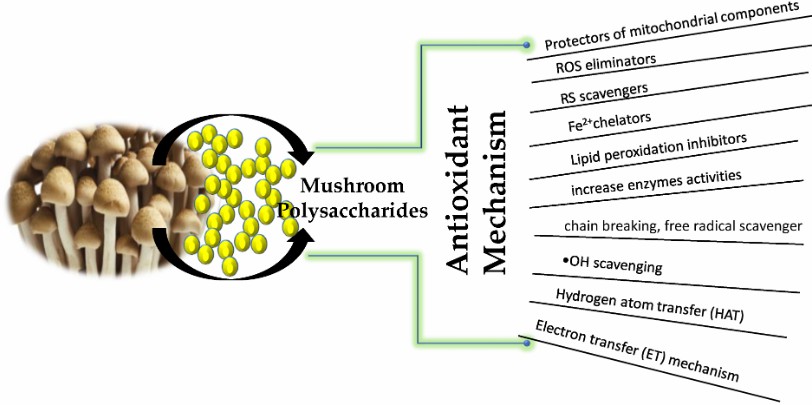Oxidative stress caused by an imbalanced metabolism and an excess of reactive oxygen species (ROS) lead to a range of health disorders. Numerous synthetic antioxidants can effectively improve defense mechanisms, but because of their adverse toxic effects under certain conditions, preference is given to natural compounds. In recent years, mushrooms have attracted attention as a natural source of antioxidants.
Lifeasible provides one-stop preclinical research services for antioxidant drug development based on mushroom components. By discovering and studying the components with antioxidant activity in mushrooms, the mechanism of antioxidation in mushrooms can be further evaluated before clinical trials, and data support can be provided for the further development of antioxidant drugs.
Mushroom Antioxidant Mechanism
Mushrooms can be used as an easily accessible source of natural antioxidants in the pharmaceutical industry. Mushrooms' antioxidant components are found in fruit bodies, mycelium, and culture, which include polysaccharides, tocopherols, phenolics, carotenoids, ergosterol, and ascorbic acid among others. The various antioxidant mechanisms of the mushroom species extract may be attributed to their strong hydrogen-donating ability, metal-chelating ability, and their effectiveness as good scavengers of superoxide and free radicals. Phenolic compounds seem to be the main components responsible for the antioxidant activity of all the mushroom species extracts.
 Fig. 1 Antioxidant mode of action of mushroom polysaccharides. (Chun S, et al., 2021)
Fig. 1 Antioxidant mode of action of mushroom polysaccharides. (Chun S, et al., 2021)
Our Services
Lifeasible provides a variety of preclinical research services for the development of antioxidant drugs based on mushroom components. Our services include but are not limited to the following:
Extraction and separation of antioxidant active substances from mushrooms.
Mushroom fruiting bodies or mycelium culture services help produce active compounds in a relatively short period of time.
Determination of antioxidant components in mushrooms.
Antioxidant activity evaluation.
We provide in vitro evaluation services for the antioxidant capacity of mushroom extracts. The method and mechanism of our in vitro evaluation of antioxidant capacity are shown in the table below:
|
Mechanisms |
Methods |
| Oxidative degradation of lipids |
Peroxide value method |
| Ferric thiocyanate method |
| Conjugated diene method |
| Thiobarbituric acid reactant method |
| Reducing capacity |
Ferric ion-reducing antioxidant power (FRAP) |
| Cupric ion reducing antioxidant capacity (CUPRAC) |
| Cyclic voltammetry (CV) |
| Folin-Ciocalteu reagent method (FC) |
| Free radical scavenging |
Oxygen Radical Absorption Capacity (ORAC) |
| Total free radical absorbance capacity |
| Hydroxyl radical scavenging capacity |
| Superoxide anion scavenging ability |
| Hydrogen peroxide scavenging ability |
| DPPH free radical method |
| ABTS free radical method |
| DMPD free radical method |
| Metal ion chelation |
Iron ion chelation ability |
| Copper ion chelation ability |
| Others |
Electrochemical method |
| HPLC method |
| GC method |
| Capillary gel electrophoresis method |
We provide in vivo evaluation of antioxidant capacity, including the construction of oxidative stress animal models and the evaluation of the in vivo antioxidant capacity of mushroom extracts. The following table shows some oxidative stress animal models and their evaluation indicators:
|
Mode |
Models |
Animal species |
Evaluation indexes |
| Nonspecific mode |
D-galactose model |
Mice, rats, guinea pigs, rabbits |
Lipid oxidation product content, protein carbonyl content, reduced glutathione content, antioxidant enzyme activity, superoxide dismutase, malondialdehyde content, etc. |
| Irradiation model |
Mice |
| Ethanol oxidative damage model |
Mice |
| Specificity mode |
Doxorubicin model |
Mice |
| Nicotine injury model |
Mice |
Advantages of Our Services
- Our model of antioxidant stress is specific, mimicking, and controllable.
- We can provide antioxidant in vivo and in vitro studies at the same time, helping to comprehensively evaluate the antioxidant capacity of antioxidant drugs.
- We have extensive experience in the cultivation of mushroom fruiting bodies and mycelium, allowing you to extract active compounds as functional ingredients in a short period of time.
Contact Us
Lifeasible provides preclinical research services for antioxidant drug development based on mushroom components, helping to promote further research and development of mushroom antioxidant potential. If you are interested in our research services, please contact us.
Reference
- Chun, S.; et al. Antioxidant activity of mushroom extracts/polysaccharides-their antiviral properties and plausible antiCOVID-19 properties. Antioxidants. 2021, 10(12): 1899.
For research or industrial raw materials, not for personal medical use!


 Fig. 1 Antioxidant mode of action of mushroom polysaccharides. (Chun S, et al., 2021)
Fig. 1 Antioxidant mode of action of mushroom polysaccharides. (Chun S, et al., 2021)